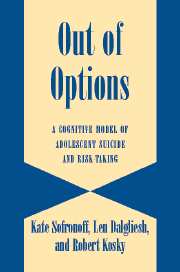Book contents
- Frontmatter
- Contents
- Preface
- Introduction
- 1 Adolescent Suicide: An Overview of the Epidemiology
- 2 Risk and Predisposing Factors in Adolescent Suicide
- 3 Emotional Problems and Adolescent Suicide
- 4 Adolescent Suicide: Cognitive Variables
- ADOLESCENT RISK-TAKING
- A MODEL OF SUICIDE AND RISK-TAKING
- AN EVALUATION OF THE S/RT MODEL
- IMPLICATIONS FOR TREATMENT
- References
- Index
4 - Adolescent Suicide: Cognitive Variables
Published online by Cambridge University Press: 03 September 2009
- Frontmatter
- Contents
- Preface
- Introduction
- 1 Adolescent Suicide: An Overview of the Epidemiology
- 2 Risk and Predisposing Factors in Adolescent Suicide
- 3 Emotional Problems and Adolescent Suicide
- 4 Adolescent Suicide: Cognitive Variables
- ADOLESCENT RISK-TAKING
- A MODEL OF SUICIDE AND RISK-TAKING
- AN EVALUATION OF THE S/RT MODEL
- IMPLICATIONS FOR TREATMENT
- References
- Index
Summary
Although we can identify adolescents in the community who, through a combination of environmental factors and individual factors, are at risk of suicide when placed in a situation of stress, we still do not have a complete picture of the process leading to the act of self-destruction. It is necessary to understand the relationship between the emotional and cognitive processes that allow adolescents to reach the belief that death is the best solution available to them. The following review looks at the cognitive factors most commonly associated with suicide risk in adolescence. They include the concepts of hopelessness, problem solving, coping, and protective factors.
Hopelessness
The role of hopelessness in adolescent suicide is based on the suggestion that how a person thinks about his or her future when depressed is more likely to influence outcomes toward suicidal behavior than feeling states (Beck, 1963, 1967). Although there was some support for this theory in research conducted with adult suicide attempters, the research using adolescents appears to be much less consistent. Rotheram-Borus and Trautman (1988) found that in a group of adolescent Hispanic and black girls, neither hopelessness nor depression predicted suicidal intent. The authors suggested that hopelessness might be a symptom of depression in adolescents rather than an independent cognitive factor predicting suicidal behavior. They also pointed out that hopelessness might not be a good predictor of suicidal intent among minority adolescents.
Cole (1989) found that mood was a more important predictor of suicide than hopelessness, especially for boys.
- Type
- Chapter
- Information
- Out of OptionsA Cognitive Model of Adolescent Suicide and Risk-Taking, pp. 43 - 56Publisher: Cambridge University PressPrint publication year: 2004



